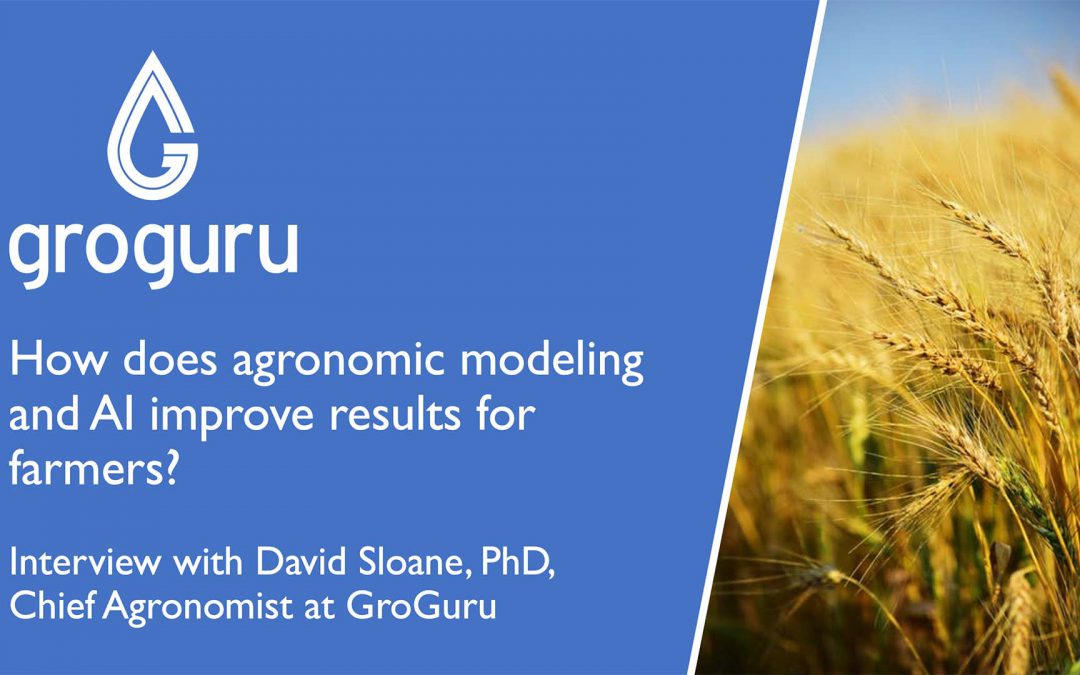How does the GroGuru solution use AI to improve results seen by farmers? In a few ways! In this interview clip with Patrick Henry, CEO and our Chief Agronomist, David Sloane, they discuss the various tech specifics of how the GroGuru underground system works in regards to AI. Watch the clip here:
Patrick: GroGuru doesn’t just do soil moisture, temperature sensing, and soil salinity sensing. We have our telemetry. We send that up to the cloud. We add other information like weather forecast, soil type, crop templates. Talk to me about the benefits of doing that from a strategic irrigation standpoint.
David: As I said with remote sensing and spatial data, I want to get it all in there. It all matters. The thing about weather data is that temperature drives development. Light drives growth. You need to know what’s going on in the environment so that you can know watch where you are in relation to where you should be. Modeling helps you look forward.
Think of a car or pickup truck. I know what my gas gage says. It really helps to know my gas mileage. Then I know how many miles I have until I need to fill up. The soil moisture sensor is like the gas gage. The model, and using ET and weather data and applying crop model, is like the trip computer. This is your mileage rate. This is how far you think you’re going to run before you need to fill up. Then you’ll also know how many gallons you need when you do need to fill up. They’re very complementary.
We want to not just look backwards but look forward and be in control of where we are today and where we need to be tomorrow. Just like a trip computer, if I’m on a long trip, I have this mapped out through the whole season. For example, I know that I’m coming into a period of high-water use.
Think of it like going over the Rocky Mountains. My gas mileage is going to go down. I need more gas to get over the mountains. If I’m coming in to tassel my corn or sizing nuts in almonds, I’m going to use more water. I need to make sure that I fill up before I get to that point so that I don’t run out halfway up the hill.
Patrick: Talk about evapotranspiration, or ET, and how it relates to weather. Explain that in layman’s terms and what that means for someone who wants to optimally irrigate their crops.
David: A crop doesn’t use the same amount of water every day of its life cycle. Corn starts out as a seed. Then it’s three inches tall. Then it grows to 10 or 12 feet tall. Then it dies. Throughout that whole life cycle, it uses different amounts of water. It needs different amounts of water. The effect if it doesn’t get the amount of water it needs is different.
You can stress a corn crop early on, and it will be fine. Yield loss will be negligible. You can stress a corn crop later in its life cycle and the effect will be much lower than if you stress it right when it’s forming grain. Between tassel and blister, it’s critical that you keep water available to it. Where this comes together with ET is that you need to know what the model looks like. What is the crop water use curve? What are the sensitive times in the crop growth cycle? When can you afford to push it a little bit and save some water, and potentially grow deeper roots, versus when do you have to look after it?
That’s where crop modeling comes in. It’s knowing the right times to put on the right amount of water. With sensing, it’s making sure that you do what you set out to do. It’s proof that you’re getting water in there. People think that they’re putting on a certain amount of water, and it isn’t necessarily so. If they think they’re putting out an inch, maybe they’re not.
Patrick: This is because of evaporation, wind, and other factors.
David: Right. I always talk about water going off target. If it’s blowing away or draining through the ground, you need to know that. You need to see that you’re delivering water to the target, which is the root zone, and that you’re maximizing that. It does come back to a season-long irrigation template, which is my plan. Just like any other factory, you need to have a way to keep it in the sweet spot.
You need to know when you’re getting outside that zone. If you get outside that sweet spot, it’s going to hurt you. If you go too wet, it might hurt because you’re creating the wrong root system. You could be washing fertilizer out of the root zone. You could be wasting water. If you’re too dry, you will be restricting yield at certain times. Other times, you want to keep it dry to keep it a little thirsty to push the crop to do things. There is a strategy involved in irrigation management.

